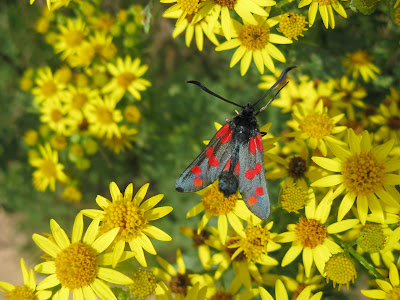












 In Oxwich, the rain had brought out interesting orange fungi. There was lots of Eyebright (Euphrasia officinalis), some Hop trefoil (Trifolium campestre), a few Lesser butterfly orchid (Platanthera bifolia) and a local white version of Rest-harrow (Ononis repens). The Stone bramble (Rubus saxatilis) had ripe fruit. In addition to the whirling masses of Gatekeeper, Meadow brown, Common blue and Small blue butterflies, there were now many Six spot burnet moth (Zygaena filipendulae) and the first appearance (the wings were not yet fully inflated) of the Grayling butterfly (Hipparchia semele). Dark bush cricket (Pholidoptera griseoaptera) were much in evidence. Beetles were represented by the first annual appearance of Cteniopus sulphureus and the Garden chafer (Phyllopertha horticola). Fly species seemed to be pre-occupied in mating and these included both hoverflies (Melanostoma sp) and robberflies (Pamponerus germanicus). Lots of activity amongst the flowers by the solitary bee Colletes halophilus.
In Oxwich, the rain had brought out interesting orange fungi. There was lots of Eyebright (Euphrasia officinalis), some Hop trefoil (Trifolium campestre), a few Lesser butterfly orchid (Platanthera bifolia) and a local white version of Rest-harrow (Ononis repens). The Stone bramble (Rubus saxatilis) had ripe fruit. In addition to the whirling masses of Gatekeeper, Meadow brown, Common blue and Small blue butterflies, there were now many Six spot burnet moth (Zygaena filipendulae) and the first appearance (the wings were not yet fully inflated) of the Grayling butterfly (Hipparchia semele). Dark bush cricket (Pholidoptera griseoaptera) were much in evidence. Beetles were represented by the first annual appearance of Cteniopus sulphureus and the Garden chafer (Phyllopertha horticola). Fly species seemed to be pre-occupied in mating and these included both hoverflies (Melanostoma sp) and robberflies (Pamponerus germanicus). Lots of activity amongst the flowers by the solitary bee Colletes halophilus.
%20mating%20NWCW.jpg)


No comments:
Post a Comment